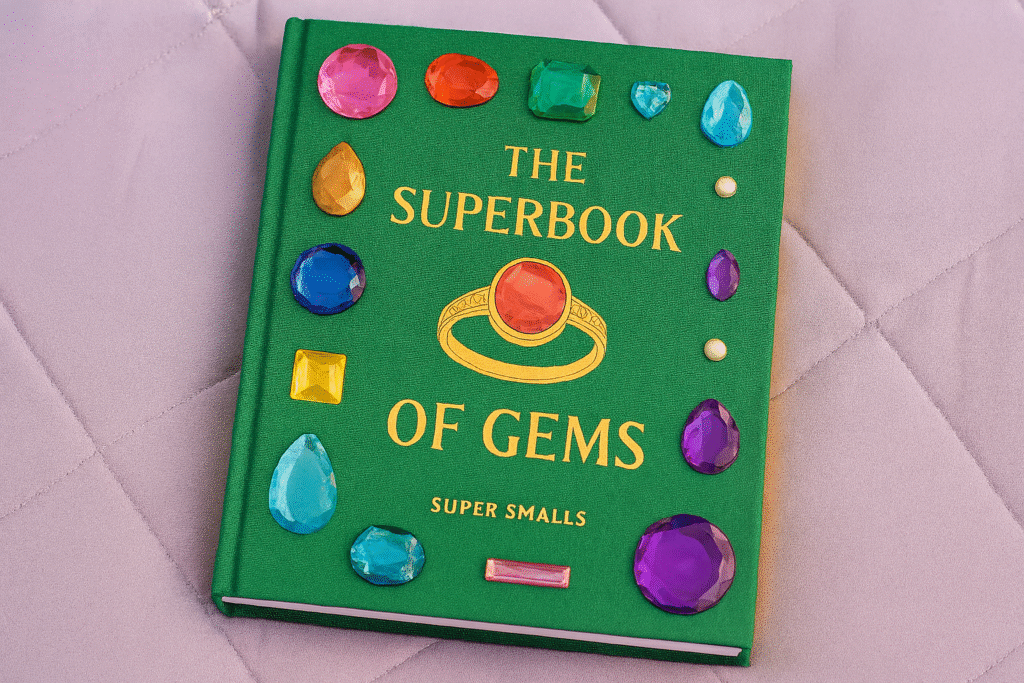Introduction
The Superbook of Gems by Super Smalls is more than just a children’s book. It is a deluxe kids’ coffee table guide that explores the fascinating world of gems and birthstones. Month by month, this book introduces young readers to twelve birthstones through stories, scientific facts, and colorful photography. Parents looking for an engaging gem book for kids will find that The Superbook of Gems by Super Smalls sparks curiosity and builds lasting knowledge about gemstones.
What Makes The Superbook of Gems by Super Smalls Special?
This gem book for kids combines history, culture, and science in a way that is easy to understand. Each chapter highlights:
- Birthstone origins and traditions
- Scientific details like hardness on the Mohs scale
- Stunning photographs of jewelry and giant gems
- Stories from history and mythology
If your child wants to explore more about how gems are studied, see the Beginner’s Guide to Gemology and Understanding BIS Hallmark.
Learn Birthstones Month by Month
From January’s garnet to December’s turquoise, The Superbook of Gems by Super Smalls takes children through a year of gems. Examples include:
- January – Garnet: A gem known for strength and protection
- April – Diamond: The most popular gemstone, making up about 78% of global gem sales
- September – Sapphire: A royal gem admired for centuries
For further reading: Visit the Gemological Institute of America (GIA) to see more gemstone research.
Why Kids Love The Superbook of Gems by Super Smalls
Research shows that visual learning improves memory retention by 65%. With full-page photos and easy-to-read facts, children stay engaged while learning about gems. Many parents note that kids look for their own birthstone after reading this book.
Expert View on Gemstone Education
With 40+ years in gemology, we know that gemstone education builds lasting interest. Books like The Superbook of Gems by Super Smalls make gems relatable to children and encourage appreciation for nature’s treasures.
For more guides, explore the articles on 24K, 22K, and 18K Gold and Engagement Ring Buying Tips.
FAQ – The Superbook of Gems by Super Smalls
Q: Who is The Superbook of Gems by Super Smalls for?
A: It is designed for children ages 6–12 but also appeals to adults who enjoy gemstones.
Q: How many gems are included?
A: The book covers 12 main birthstones, plus highlights of other rare gems.
Q: Can this book be used for school projects?
A: Yes, the mix of history, science, and culture makes it an excellent reference.
Q: Does it include real gemstone photos?
A: Yes, it contains both illustrations and high-quality photographs.
This comprehensive global cuisine FAQ covers everything about Asian and Western food and drinks. Whether you’re exploring international cooking techniques or discovering new flavors, this global cuisine FAQ answers the most frequently asked questions about world food traditions, ingredients, and culinary practices from both Eastern and Western cultures.
Global Cuisine FAQ: Asian & Western Food & Drinks
Food reveals cultural contrasts in clear and delicious ways. From cooking methods to dining customs, Asian and Western cuisines showcase unique traditions while also offering fascinating overlaps. Below, you’ll find answers to the most common questions about these culinary worlds.
Understanding Core Differences in Cuisine
1. What distinguishes Asian and Western culinary traditions?
Asian meals often rely on rice or noodles as a foundation. Flavors usually come from soy sauce, ginger, garlic, and a wide variety of spices. Meanwhile, Western gastronomy emphasizes bread, potatoes, and pasta. Dairy plays a key role, with butter, cream, and cheese giving richness to many dishes. Herbs such as rosemary and thyme highlight European cooking. These contrasts create distinct dining habits and flavor profiles.
2. Are Asian dishes always spicy?
No, not at all. While cuisines from Thailand and parts of India feature bold use of chilies, not every dish follows this pattern. Japanese sushi, Chinese dim sum, and Korean bulgogi are mild examples. In fact, Asian cuisines range from fiery to delicate, showcasing a rich palette of flavor.
Western Breakfast Staples and Comfort Foods
1. What constitutes typical Western morning meals?
Western breakfasts often include eggs, bacon, and toast. Pancakes, waffles, and cereal are also popular choices. These hearty starts are usually enjoyed with coffee, tea, or juice, providing both energy and comfort.
2. What represents popular Western comfort foods?
Comfort foods in the West speak to nostalgia and indulgence. Creamy macaroni and cheese, pizza, and hearty casseroles are favorites. Similarly, burgers and fried chicken have wide appeal. Because they are warm, filling, and familiar, these dishes strongly connect to emotion.
Cultural Dining Practices
1. Do all Asian cultures employ chopsticks?
No. Chopsticks dominate in East Asia—China, Japan, and Korea. However, Southeast Asia prefers spoons and forks, while India and parts of the Middle East often use flatbreads or hands. This diversity highlights how food customs closely reflect culture.
2. Why are some Asian foods fermented?
Fermentation preserves food while also enhancing nutrition and flavor. Korean kimchi, Japanese miso, and Indonesian tempeh show how tradition meets health benefits. These foods are valued not only for taste but also for their role in well-being.
Common Western Beverages
1. What beverages are common with Western meals?
Western dining often features water, soda, or fresh juice. Alcohol also has a strong cultural connection, with wine served at European dinners and beer central in North America. In the southern United States, sweet iced tea is a staple.
Dietary Flexibility and Options
1. Can one discover plant-based options easily?
Yes. Asian cuisines offer tofu stir-fries, lentil dals, and vegetable curries that are naturally vegetarian. Western food, similarly, embraces plant-based eating. Salads, vegetarian pastas, and vegan burgers have grown popular, making meat-free dining accessible worldwide.
Unique Asian Drinks to Explore
1. What are some unique Asian beverages?
Asia provides a wide variety of distinctive drinks. Bubble tea, from Taiwan, combines tea with chewy tapioca pearls. Japanese sake, made from rice, holds deep cultural meaning. Strong Vietnamese iced coffee, sweetened with condensed milk, adds a bold twist compared to Western brews.
Portion Sizes and Dining Habits
1. How do portion sizes compare?
Western meals often emphasize large servings, reflecting abundance. By contrast, Asian meals are usually smaller yet balanced, encouraging sharing and mindful eating. This creates different social experiences around the table.
The Art of Fusion Cuisine
1. Is it feasible to integrate Asian and Western flavors?
Absolutely. Fusion cuisine blends traditions in creative ways. For instance, teriyaki burgers combine Japanese flavors with American fast food, while kimchi tacos bring Korean spice to Mexican street food. These playful mixes show how food bridges cultures.




